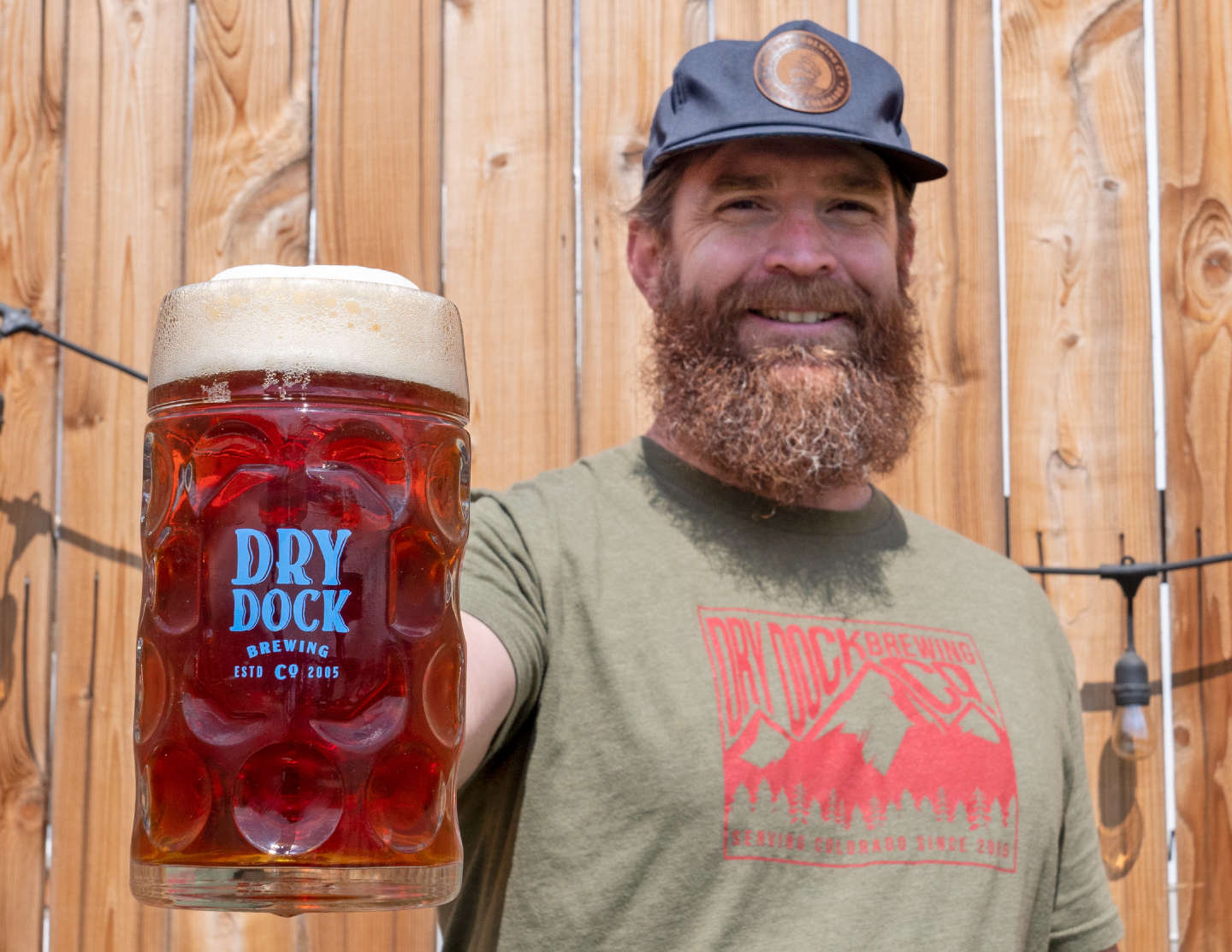
By Marty Jones
Dry Dock Brewing Co. co-founder Kevin DeLange understands what makes his brewery’s Docktoberfest lager wonderful. “It’s a beautifully balanced beer,” DeLange says of his annual fall treat. “It’s malty, but it’s not too sweet, and it has just the right amount of hops to balance it all out.”
While deft balance is an attribute of many of his brewery’s acclaimed beers (since its founding in 2005, no other Colorado craft brewery has won as many Great American Beer Festival and World Beer Cup awards as Dry Dock), Docktoberfest has unique merits. “It’s the only beer we make that gets its own giant release party each year,” DeLange says. “The Mayor doesn’t come out here to tap the first keg of any other beer we make.”
On September 18, from 11 AM to 5 PM, Aurora’s mayor will do just that before a crowd of lager-lovers eager to get their German on at Dry Dock’s annual Docktoberfest party. In addition to the namesake Marzen-style lager, attendees can quaff four other German-style beers from Dry Dock’s brewers while enjoying live polka music, food-truck treats, and all of the gemutlichkeit they can handle.
Homebrewers at the event can also get the recipe and ingredients to make the day’s featured beer since long-running homebrew shop The Brew Hut literally adjoins Dry Dock’s South Dock brewery and tasting room. DeLange and partner Michelle Reding took over the shop in 1999. Their brewery was born from The Brew Hut when the pair founded Dry Dock in a tiny space next door to the homebrew store.

For homebrewers looking to brew Docktoberfest or some other Oktoberfest beer, Dry Dock head brewer Alan Simons and Brew Hut manager Mark Hurley are here to offer tips.
Choose Your Malts Wisely
“If you want your beer to be authentic,” Simons says, “you’ll want to use German ingredients in your recipe. From the malts and hops to the yeast strain.” That’s why he recommends a toasted malt like Vienna or Munich for a base malt. In addition to authenticity, Simons says they provide crucial flavors for an Oktoberfest worthy of its stein. “A good Marzen should be malty sweet, but not overly caramel,” he says. “From those two malts, you’ll get malty sweet, honey, bready, and nutty flavor profiles.”
Simons suggests using crystal or “cara” malts cautiously or avoiding them entirely to further fend off the chance for a caramel-heavy beer. “A Marzen with too much caramel,” he notes, “can be heavy and cloying. These beers should be drinkable and repeatable.” And if it’s possible, he highly recommends homebrewers make their Oktoberfest via the decoction method for maximum German-style character.
Hop It Likes It’s German
This tradition-honoring style calls for the appropriate trad’ hops. For Docktoberfest, Simons turns to Hallertau Mittelfruh used in measured amounts. “Again, I’m all for authenticity,” he notes, “and I really like Mittlefruh.” He’s also a fan of Hallertau Hersbrucker. The restrained hops in the recipe ensure the beer fits its “little to no hop aroma or flavor” trait.
Want to reduce hop load and get a boosted hop yield? Simons suggests a higher alpha acid hop such as German Perle or Magnum hops. “I think a 60-minute and/or a 45-minute addition is sufficient,” Simons says. He’s also a fan of a light first-wort addition, even if the style doesn’t call for much hop aroma or flavor. “It may not be enough to stand out,” he notes, “but I find it contributes additional depth.”
Yeast Volume & Fermentation Temperature
A German yeast is vital for this recipe, and Hurley recommends the Augustiner-style Harvest strain. “But pitching the appropriate amount of yeast for an Oktoberfest is also really essential,” he says, to prevent unwelcome fruity esters and spicy/clove phenols. “These flavors,” he says, “can develop if the yeast is under stress from temperature extremes or from a low cell count.”
For a Marzen, he also recommends a yeast pitch that’s two to three times higher than what is typically used in an ale. “A good general rule,” he says, “is to use between 1.5 and 1.75 million cells/ml/degrees Plato. This can be calculated using yeast pitch rate calculators like the one at our Brew Hut website.” (See it at https://thebrewhut.com/resources-recipes/brewing-calculators/ )
Timing is Everything
Once fermentation is underway, Simons says it’s important to get your beer off of the majority of its spent yeast before aging. “If you don’t,” he says, “it can lead to yeast autolysis that will contribute some nasty flavors to your beer. I see this often when judging homebrewed lagers.” He recommends moving the beer into a secondary fermenter three or four days after reaching terminal gravity.
Before moving the beer to its new home, he advises a purge of that secondary fermenter with CO2. Skip that step, Simons notes, “and you’re transferring your beer onto a lot of oxygen. And oxygen is the number one enemy of beer. I know some homebrewers have had success without this CO2 purge, but your beer will absolutely be better if you can do it.”
For your fermentation plan, properly controlled temperature is vital for a true-to-style character. “Temperature has a huge effect on the flavor of an Oktoberfest,” Hurley says. “Lagers should be fermented cool around 45F to 55F.” Hurley recommends a refrigerator with a temperature controller for a simple way to do temp-controlled fermentation. With fermentation temps in the correct range, yeast can work its magic without stress or unwanted flavors, with little chance of getting too cold and going dormant.


As primary fermentation is finishing, Hurley suggests a temperature boost to 60F for a thorough three-day diacetyl rest. “Then you can slowly drop the beer down to lagering temperatures,” Hurley says, “by a couple of degrees a day until it reaches about 35F degrees.” Hold the beer at that temp for 8-12 weeks until it’s crystal clear, and then start putting your beer-release party plan into action.
All of which leads to a sixth tip for making your Oktoberfest classic: Practice Good Planning. While Marzen is a delicious treat throughout the year, if you want homemade Oktoberfest on its traditional mid-September calendar date, work backward on the calendar and plan your brew day accordingly. Doing so provides ample aging time for your beer and time for other important steps: ordering your dirndl or lederhosen, finding the right bratwurst, and — this is very important — lining up an accordion player for the tapping day. (Squeezebox players can always use more work, but they’re hard to book if you wait too close to September.) And since your beer is going to turn out really good, you’ll want to give your mayor time to work your Oktoberfest release party into his schedule, right?
About the Author
Marty Jones is a longtime craft beer journalist, promoter, and publicist. He lives in Denver, Colorado and helps Dry Dock Brewing with its flag-waving efforts.



Share Post